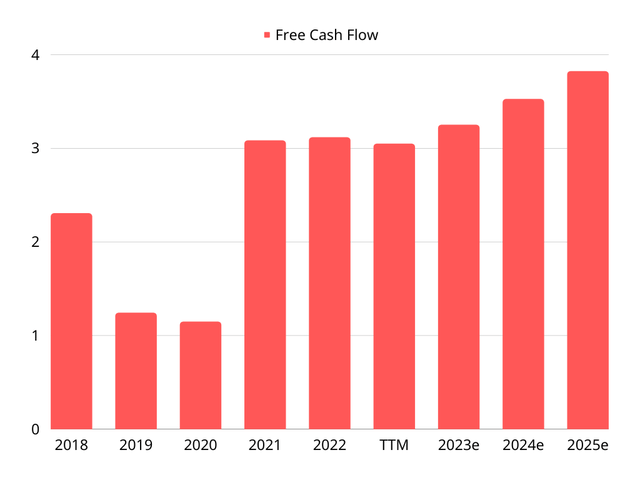The China Factor: Analyzing The Difficulties Faced By BMW, Porsche, And Other Automakers

Table of Contents
Navigating the Complex Chinese Regulatory Landscape
China's automotive regulatory environment is notoriously intricate. Foreign automakers face a complex web of regulations concerning foreign investment, emissions standards, safety requirements, and data security. Successfully operating within this framework demands significant resources and expertise.
- Stricter Emission Standards: China is a global leader in pushing for stricter emission standards, forcing automakers to invest heavily in developing cleaner vehicles to meet these requirements.
- Complex Import Duties and Tariffs: High import duties and tariffs significantly increase the cost of importing vehicles, impacting profitability and competitiveness.
- Bureaucratic Hurdles and Lengthy Approval Processes: The process of getting new models approved for sale in China can be lengthy and bureaucratic, delaying market entry and potentially missing critical sales windows.
- Data Localization and Cybersecurity Regulations: Growing concerns over data security have led to stringent regulations on data localization and cybersecurity, demanding significant investments in infrastructure and compliance.
- Government Incentives Favoring Domestic Brands: The Chinese government actively supports domestic automakers through subsidies and preferential treatment, creating an uneven playing field for foreign competitors.
The increased compliance costs associated with navigating these China automotive regulations are substantial, necessitating specialized legal expertise and significant internal resources dedicated to regulatory compliance.
Intense Competition from Domestic Chinese Automakers
The rise of domestic Chinese automakers presents a formidable challenge to established luxury brands. The speed and scale of their growth, particularly in the electric vehicle (EV) sector, is unprecedented.
- Rise of Strong Domestic Brands: Companies like Nio, Xpeng, and BYD are rapidly gaining market share, offering technologically advanced and competitively priced vehicles.
- Competitive Pricing Strategies: Chinese brands often adopt aggressive pricing strategies, undercutting foreign competitors and targeting price-sensitive consumers.
- Focus on Technological Innovation: Chinese EV manufacturers are at the forefront of technological innovation, integrating cutting-edge features and connectivity solutions.
- Government Support for Domestic EV Manufacturers: Significant government support fuels the rapid growth of domestic EV manufacturers, giving them a competitive advantage.
This intense domestic competition in the electric vehicles (EV) market significantly impacts the market share of established luxury brands, forcing them to adapt and innovate to remain competitive.
Understanding and Catering to Unique Chinese Consumer Preferences
Understanding and adapting to Chinese consumer preferences is crucial for success. These preferences differ significantly from those in Western markets, requiring careful consideration in product development and marketing.
- Emphasis on Technology and Digital Features: Chinese consumers place a high value on technologically advanced features and seamless digital integration in their vehicles.
- Preference for Specific Vehicle Sizes and Styles: There's a strong preference for certain vehicle sizes and styles, which may not align with those popular in other regions.
- Growing Importance of Brand Image and Social Status: Luxury car purchases often carry significant social status in China, influencing brand choices and purchasing decisions.
- Increased Demand for Electric and Hybrid Vehicles: The demand for electric and hybrid vehicles is rapidly growing in China, driven by government policies and environmental awareness.
- Unique After-Sales Service Expectations: Chinese consumers have specific expectations regarding after-sales service and customer support, demanding high levels of attention and responsiveness.
Luxury brands must effectively adapt their products and marketing strategies to cater to these unique Chinese consumer preferences to gain traction in this competitive market.
Economic and Geopolitical Factors
External economic and geopolitical factors further complicate the already challenging landscape for international automakers.
- Economic Slowdown: Economic fluctuations and potential slowdowns directly impact consumer spending, affecting demand for luxury vehicles.
- Impact of Trade Disputes: Trade disputes and tariffs between China and other countries can disrupt supply chains and increase costs.
- Geopolitical Risks: Geopolitical risks and instability can create uncertainty and negatively affect business operations.
- Currency Exchange Rate Fluctuations: Fluctuations in currency exchange rates can impact profitability and pricing strategies.
These economic fluctuations, trade wars, and geopolitical risks add another layer of complexity for international automakers operating in the Chinese market, highlighting the importance of robust risk management strategies.
Conclusion: Overcoming the China Factor Challenges
The China factor presents a multifaceted challenge for automakers like BMW and Porsche. Navigating the complex regulatory landscape, competing with rapidly growing domestic brands, understanding unique consumer preferences, and accounting for economic and geopolitical uncertainties are all critical considerations. However, success is possible. Some brands have demonstrated success through localization strategies, joint ventures with local partners, and tailored marketing campaigns that resonate with Chinese consumers. Understanding and effectively addressing these challenges is vital for long-term success in this crucial market. To delve deeper, we encourage further research into specific aspects of the China automotive market, perhaps focusing on a single brand's approach to regulatory compliance or analyzing consumer trends within a specific vehicle segment. Mastering the China factor is key to unlocking the immense potential of this dynamic market.

Featured Posts
-
 The Ethics Of Betting On Natural Disasters The Los Angeles Wildfires Example
May 25, 2025
The Ethics Of Betting On Natural Disasters The Los Angeles Wildfires Example
May 25, 2025 -
 Classic Art Week 2025 Porsche Hadirkan Perpaduan Seni Dan Otomotif Di Indonesia
May 25, 2025
Classic Art Week 2025 Porsche Hadirkan Perpaduan Seni Dan Otomotif Di Indonesia
May 25, 2025 -
 Southern Vacation Destination Addresses Safety Concerns Following Shooting Incident
May 25, 2025
Southern Vacation Destination Addresses Safety Concerns Following Shooting Incident
May 25, 2025 -
 Planning Your Country Escape Location Lifestyle And Logistics
May 25, 2025
Planning Your Country Escape Location Lifestyle And Logistics
May 25, 2025 -
 Weak Q1 Figures Cause 6 Fall In Kering Share Price
May 25, 2025
Weak Q1 Figures Cause 6 Fall In Kering Share Price
May 25, 2025
Latest Posts
-
 Rising Tennis Stars In China A Boost To The Nations Sporting Culture
May 25, 2025
Rising Tennis Stars In China A Boost To The Nations Sporting Culture
May 25, 2025 -
 Chinas Tennis Boom Top Players Impact According To Italian Open Chief
May 25, 2025
Chinas Tennis Boom Top Players Impact According To Italian Open Chief
May 25, 2025 -
 Allagi Pleysis Gia Tin Mercedes O Verstappen Pleon Ektos Sxedion
May 25, 2025
Allagi Pleysis Gia Tin Mercedes O Verstappen Pleon Ektos Sxedion
May 25, 2025 -
 Verstappen Vs Mercedes I Nea Dynamiki Stin Formula 1
May 25, 2025
Verstappen Vs Mercedes I Nea Dynamiki Stin Formula 1
May 25, 2025 -
 The Turning Point George Russells Key Decision For Mercedes Improvement
May 25, 2025
The Turning Point George Russells Key Decision For Mercedes Improvement
May 25, 2025
